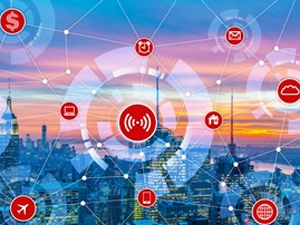



Date:09/01/19
 Global spending on the Internet of Things (IoT) is expected to hit almost $750 billion in 2019, according to the latest figures from IDC.
Global spending on the Internet of Things (IoT) is expected to hit almost $750 billion in 2019, according to the latest figures from IDC.
The analyst firm put out its figures as an update to its Worldwide Semiannual Internet of Things Spending Guide. The company’s previous analysis, in June, put the figure at $1.2 trillion by 2022 – which may suggest a huge push this year before slowdown and consolidation in the years to come.
Either way, this traditional crystal ball perusal makes for interesting reading when looking at the different sectors. Manufacturing is considered to be the biggest spender according to the research – discrete manufacturing contributing $119 billion with process manufacturing at $78bn, while transportation ($71bn) and utilities ($61bn) are not too far behind.
But what does this mean in terms of use cases? Airport facility automation is seen as the most popular case. Yet IDC notes the top five – electric vehicle charging, agriculture field monitoring, bedside telemetry, and in-store contextualised marketing – are all very close together.
Looking at the most IoT friendly countries, it may not be a surprise that the US, at $194 billion, and China, at $182bn, are top of the shop by a considerable distance. Japan ($65.4bn), Germany ($35.5bn) and Korea ($25.7bn) round off the top five.
While the enterprise is evidently the larger market and one with the greatest potential, consumer IoT spending will account for $108 billion in 2019, with leading cases naturally around smart homes, personal wellness and infotainment for connected vehicles.
“Adoption of IoT is happening across industries, in governments, and in consumers’ daily lives. We are increasingly observing how data generated by connected devices is helping businesses run more efficiently, gain insight into business processes, and make real-time decisions,” said Carrie MacGillivray, VP Internet of Things and mobility at IDC.
“The next chapter of IoT is just beginning as we see a shift from digitally enabling the physical to automating and augmenting the human experience with a connected world,” MacGillivray added.
Global IoT spending to reach $745 billion in 2019, says IDC
 Global spending on the Internet of Things (IoT) is expected to hit almost $750 billion in 2019, according to the latest figures from IDC.
Global spending on the Internet of Things (IoT) is expected to hit almost $750 billion in 2019, according to the latest figures from IDC.The analyst firm put out its figures as an update to its Worldwide Semiannual Internet of Things Spending Guide. The company’s previous analysis, in June, put the figure at $1.2 trillion by 2022 – which may suggest a huge push this year before slowdown and consolidation in the years to come.
Either way, this traditional crystal ball perusal makes for interesting reading when looking at the different sectors. Manufacturing is considered to be the biggest spender according to the research – discrete manufacturing contributing $119 billion with process manufacturing at $78bn, while transportation ($71bn) and utilities ($61bn) are not too far behind.
But what does this mean in terms of use cases? Airport facility automation is seen as the most popular case. Yet IDC notes the top five – electric vehicle charging, agriculture field monitoring, bedside telemetry, and in-store contextualised marketing – are all very close together.
Looking at the most IoT friendly countries, it may not be a surprise that the US, at $194 billion, and China, at $182bn, are top of the shop by a considerable distance. Japan ($65.4bn), Germany ($35.5bn) and Korea ($25.7bn) round off the top five.
While the enterprise is evidently the larger market and one with the greatest potential, consumer IoT spending will account for $108 billion in 2019, with leading cases naturally around smart homes, personal wellness and infotainment for connected vehicles.
“Adoption of IoT is happening across industries, in governments, and in consumers’ daily lives. We are increasingly observing how data generated by connected devices is helping businesses run more efficiently, gain insight into business processes, and make real-time decisions,” said Carrie MacGillivray, VP Internet of Things and mobility at IDC.
“The next chapter of IoT is just beginning as we see a shift from digitally enabling the physical to automating and augmenting the human experience with a connected world,” MacGillivray added.
Views: 444
©ictnews.az. All rights reserved.Similar news
- Azerbaijani project to monitor disease via mobile phones
- Innovative educational system to be improved under presidential decree
- NTRC prolongs license of two TV and radio organizations for 6 years
- Azerbaijan establishes e-registry for medicines
- Azerbaijani museum introduces e-guide
- Nar Mobile opens “Nar Dunyasi” sales and service center in Siyazan city
- International conference on custom electronic services held in Baku
- OIC secretary general to attend COMSTECH meeting in Baku
- Azerbaijan develops earthquake warning system
- New law to regulate transition to digital broadcasting in Azerbaijan
- Azerbaijani State Social Protection Fund introduces electronic digital signature
- Intellectual traffic management system in Baku to be commissioned in December
- Tax Ministry of Azerbaijan started receiving video-addresses
- World Bank recommends Azerbaijan to speed up e-service introduction in real estate
- Azerbaijan to shift to electronic registration of real estate





















